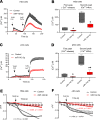T cell exosome-derived miR-142-3p impairs glandular cell function in Sjögren's syndrome
- PMID: 32376798
- PMCID: PMC7253014
- DOI: 10.1172/jci.insight.133497
T cell exosome-derived miR-142-3p impairs glandular cell function in Sjögren's syndrome
Abstract
Sjögren's syndrome (SS) is a systemic autoimmune disease that mainly affects exocrine salivary and lacrimal glands. Local inflammation in the glands is thought to trigger glandular dysfunction and symptoms of dryness. However, the mechanisms underlying these processes are incompletely understood. Our work suggests T cell exosome-derived miR-142-3p as a pathogenic driver of immunopathology in SS. We first document miR-142-3p expression in the salivary glands of patients with SS, both in epithelial gland cells and within T cells of the inflammatory infiltrate, but not in healthy volunteers. Next, we show that activated T cells secreted exosomes containing miR-142-3p, which transferred into glandular cells. Finally, we uncover a functional role of miR-142-3p-containing exosomes in glandular cell dysfunction. We find that miR-142-3p targets key elements of intracellular Ca2+ signaling and cAMP production - sarco(endo)plasmic reticulum Ca2+ ATPase 2b (SERCA2B), ryanodine receptor 2 (RyR2), and adenylate cyclase 9 (AC9) - leading to restricted cAMP production, altered calcium signaling, and decreased protein production from salivary gland cells. Our work provides evidence for a functional role of the miR-142-3p in SS pathogenesis and promotes the concept that T cell activation may directly impair epithelial cell function through secretion of miRNA-containing exosomes.
Keywords: Autoimmune diseases; Autoimmunity.
Conflict of interest statement
Figures








Similar articles
-
Targeting the Ca(2+) Sensor STIM1 by Exosomal Transfer of Ebv-miR-BART13-3p is Associated with Sjögren's Syndrome.EBioMedicine. 2016 Aug;10:216-26. doi: 10.1016/j.ebiom.2016.06.041. Epub 2016 Jun 29. EBioMedicine. 2016. PMID: 27381477 Free PMC article.
-
SHED-Derived Exosomes Ameliorate Sjögren's Syndrome-Induced Hyposalivation by Suppressing Th1 Cell Response via the miR-29a-3p/T-bet Axis.ACS Appl Mater Interfaces. 2025 Jan 29;17(4):5752-5761. doi: 10.1021/acsami.4c16595. Epub 2025 Jan 13. ACS Appl Mater Interfaces. 2025. PMID: 39803988 Free PMC article.
-
Dual function of miR-1248 links interferon induction and calcium signaling defects in Sjögren's syndrome.EBioMedicine. 2019 Oct;48:526-538. doi: 10.1016/j.ebiom.2019.09.010. Epub 2019 Oct 6. EBioMedicine. 2019. PMID: 31597594 Free PMC article.
-
Autoimmune epithelitis (Sjögren's syndrome); the impact of metabolic status of glandular epithelial cells on auto-immunogenicity.J Autoimmun. 2019 Nov;104:102335. doi: 10.1016/j.jaut.2019.102335. Epub 2019 Sep 18. J Autoimmun. 2019. PMID: 31540861 Review.
-
Cytokines in Sjögren's syndrome.Oral Dis. 2009 Nov;15(8):519-26. doi: 10.1111/j.1601-0825.2009.01582.x. Epub 2009 Jun 10. Oral Dis. 2009. PMID: 19519622 Free PMC article. Review.
Cited by
-
Diagnostic and therapeutic potentials of extracellular vesicles for primary Sjögren's Syndrome: A review.Dent Rev (N Y). 2024 Sep;4(3):100150. doi: 10.1016/j.dentre.2024.100150. Epub 2024 Aug 13. Dent Rev (N Y). 2024. PMID: 39310092 Free PMC article.
-
Extracellular vesicles and lipoproteins - Smart messengers of blood cells in the circulation.J Extracell Biol. 2022 Jul 5;1(7):e49. doi: 10.1002/jex2.49. eCollection 2022 Jul. J Extracell Biol. 2022. PMID: 38938581 Free PMC article. Review.
-
Age-Related Oral and Para-Oral Tissue Disorders: The Evolving Therapeutic and Diagnostic Potential of Exosomes.Dent J (Basel). 2025 Feb 27;13(3):106. doi: 10.3390/dj13030106. Dent J (Basel). 2025. PMID: 40136734 Free PMC article. Review.
-
Exosomes in Systemic Autoimmune Diseases: Recent Advances in Diagnostic Biomarkers and Therapeutic Applications.Int J Nanomedicine. 2025 Apr 21;20:5137-5160. doi: 10.2147/IJN.S506221. eCollection 2025. Int J Nanomedicine. 2025. PMID: 40292402 Free PMC article. Review.
-
Exosomal non-coding RNAs: gatekeepers of inflammation in autoimmune disease.J Inflamm (Lond). 2025 May 14;22(1):18. doi: 10.1186/s12950-025-00443-z. J Inflamm (Lond). 2025. PMID: 40369549 Free PMC article. Review.
References
-
- Brito-Zerón P, et al. Influence of geolocation and ethnicity on the phenotypic expression of primary Sjögren’s syndrome at diagnosis in 8310 patients: a cross-sectional study from the Big Data Sjögren Project Consortium. Ann Rheum Dis. 2017;76(6):1042–1050. doi: 10.1136/annrheumdis-2016-209952. - DOI - PubMed
Publication types
MeSH terms
Substances
Grants and funding
LinkOut - more resources
Full Text Sources
Medical
Miscellaneous

